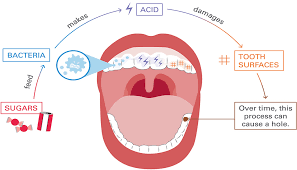What is gum disease and how do I know if I have it?
There are several reason why you might be suffering from bleeding gums:
- In some cases, bleeding gums can be a sign of gingivitis, the early stage of periodontal disease. If your gums bleed easily or bleed when you brush, talk to your dentist about your oral health. Gingivitis is reversible and preventable.
- If you’ve just started a new flossing routine, for instance, your gums may bleed at first as they get used to cleaning between the teeth. This usually goes away on its own in about a week.
- Some pregnant women develop a condition known as “pregnancy gingivitis,” an inflammation of the gums that can cause swelling and tenderness.
- Gums also may bleed a little when brushing or flossing. If you take blood thinners, these medications may cause your gums to bleed. Contact your physician if the bleeding does not stop quickly.
- Your gums could also be bleeding if you brush too hard. Use an extra-soft or soft-bristled toothbrush when brushing your teeth.
If your gums bleed regularly or enough to worry you, make an appointment with your dentist or physician. It could be a sign that something else is wrong.
Always remember to brush your teeth twice a day, floss once a day and schedule regular dental visits.
Book your next dental appointment here
Gum disease is an infection of the tissues surrounding the teeth. Infection leads to a red, swollen and tender area. This area often bleeds when the teeth are brushed or the tender area is touched.
How does gum disease come about?
- Gum disease comes about when large amounts of bacteria branch together to form a sticky substance called plaque. This plaque lives where the gum and the teeth meet and can cause extreme irritation leading to a red, swollen and tender area. As the area becomes more swollen, the gums separate from the teeth leading to the development of a pocket where more dental plaque lives and eventually damages the gum and kills the bone around your tooth.
There are a number of signs and symptoms that may indicate you have gum disease:
- Dark red or swollen gums
- Tender or bleeding gums
- Pain when you bite on food
- Gums that look like they are low down on the teeth
- Sensitive or loose teeth
- Smelly breath
Prevention at home
- Brush where the teeth and gums meet, twice a day with a fluoride toothpaste
- Change your toothbrush when the bristles become flattened.
- Clean between your teeth with floss or interdental brushes everyday.
- Avoid sugary snacks between meals
- Do not smoke.
- Visit your own dentist and dental hygienist regularly.
Dental treatments
As dentists, we often carry out/subscribe the following treatments/prescription when dealing with gum disease:
- A thorough scale and polish
- Root planning (the cleaning of bacteria from the roots of your teeth).
- Antibiotics (to treat any infection)
- Extraction (to remove affected tooth or teeth)
If you are experiencing any of the above symptoms or simply feel like an oral health review is overdue, book an appointment with one of our general dentists here.
The Stages of Dental Implant Treatment
Dental implant surgery is usually performed in the following stages:
- Damaged tooth/teeth are extracted.
- Your jawbone is prepared for surgery, a process that may involve bone grafting.
- After your jawbone heals, Dr Grigolli, our implantologist places the dental implant post in your jawbone.
- You will go through a healing period that may last several months (this is different for every patient).
- Dr Grigolli places the abutment, which is an extension of the implant metal post.
- When your soft tissue heals, moulds of your teeth and jawbone will be made and later placed; the final tooth or teeth.
The entire dental implant process can take many months from beginning to end. A large portion of this time is devoted to healing and waiting for the growth of new bone in your jaw.
After the procedure
Whether you have dental implant surgery in one stage or multiple stages, you may experience some of the typical discomforts associated with any type of dental surgery, such as:
- Swelling of your gums and face
- Bruising of your skin and gums
- Pain at the implant site
- Minor bleeding
 If swelling, discomfort or any other problem worsens in the days after surgery, contact the clinic. You may need pain medications or antibiotics.
If swelling, discomfort or any other problem worsens in the days after surgery, contact the clinic. You may need pain medications or antibiotics.
After each stage of surgery, you may need to eat soft foods while the surgical site heals. Typically, Dr Grigolli will use stitches that dissolve on their own. If your stitches aren’t self-dissolving, Dr Grigolli removes them.
If you would like to find out more about dental implants, book a consultation with Dr Wilson Grigolli here.
Sugar and your oral health – how to break the habit
Sugar is the single largest cause of dental caries (or tooth decay as it is more commonly known)
The facts:
- Twenty-three percent of 8-year-olds and 40% of 15-year-olds consume sweet snacks or drinks between normal meals three or more times a day10; half (48%) of all adults snack between meals, most commonly on biscuits and cakes.
- More than 8 out of 10 adults (86%) consume at least three servings a day of foods high in fats and sugar. The Food Pyramid recommends that these foods are best avoided and limited to “no more than 1 serving a day maximum and ideally not everyday.”
- Poor nutrition is a “shared common risk factor” for cardiovascular diseases, cancer, obesity and oral diseases.
- A healthy diet for oral health should be promoted as part of general nutrition advice.
(Source: Dental Health Foundation 2018)
How to cut your sugar intake:
- Swap out the sugary fizzy drinks for their diet versions. Water is best, but if you really want something sweet to drink diet drinks can be a better choice than sugary ones.
- Avoid fruit canned in syrup, especially heavy syrup. Drain and rinse in a colander to remove excess syrup or juice.
- Check food labels and choose products with the lowest amounts of added sugars. Dairy and fruit products will contain some natural sugars. Added sugars can be identified in the ingredients list.
- Replace it completely. Enhance foods with spices instead of sugar. Try ginger, allspice, cinnamon or nutmeg.
- Try extracts. Instead of adding sugar in recipes, use extracts like almond, vanilla, orange or lemon.
- When baking cookies or cakes, cut the sugar in your recipe by one-third to a half. Often you won’t notice the difference.
- Use fresh fruit such as raspberries or blueberries to sweeten your breakfast cereal.
Keep your oral health in check, schedule regular dental exams and let us help you maintain a healthy smile. Click here to book.
How much sugar is too much sugar?
Sugars in food and drinks play a major role in the development of tooth decay. Bacteria within the plaque use the sugar as energy and release acid as a waste product, which gradually dissolves the enamel in the teeth.
Everyone is at risk of tooth decay, but children and teens are most at risk. Dental caries are the most common cause of tooth loss in young people. Plaque begins to build up on teeth only 20 minutes after we begin eating and if it is not removed effectively, tooth decay starts. People who regularly consume sugar have a higher risk of developing dental caries, particularly if the food they eat is sticky or consumed in between mealtimes. Sugar-containing snacks and sweetened beverages have particularly bad effects on teeth.
We currently consume far too much sugar in our diets. A report published by the World Health Organisation highlights the need for a reduction in sugars intake to 5% of our energy intake. This is the equivalent of 7 teaspoons/cubes or 30g of sugar per day for an adult. The recommendation for children is 24g for children aged 5-11 and 19g for children aged 4-6. This 5% limit is far below the current intake which is of 11.9% in children aged 1.5 to 3; 14.7% in children aged 4 to 10; and 15.6% in children 11 to 18. It is also thought that adherence to the 5% recommended sugar intake would halt the increase in obesity.
Ways to reduce your risk of tooth decay:
- Brushing teeth thoroughly twice a day with fluoride-containing toothpaste as well as flossing daily.
- Reducing the amount of sugars-containing sticky food, and rinsing the mouth with water if they are consumed.
- Reduce snacking; which helps reduce the production of acid in the mouth.
- Reduce the consumption of sugars-sweetened beverages.
- Only eat sugary foods at mealtimes.
To book an oral health review and talk to one of our general dentists about how you can protect your teeth from decay click here.



